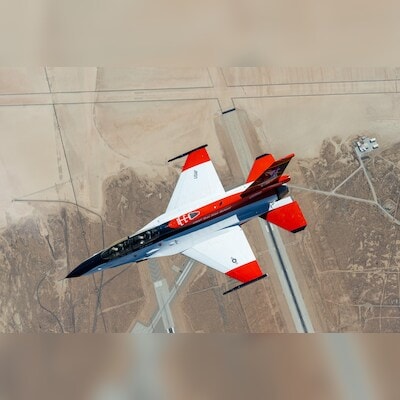)
The X-62 Variable In-Flight Simulator Test Aircraft (VISTA) flies in the skies over Edwards Air Force Base, California, Aug 26, 2022. Photo credit: US Air Force photo by Kyle Brasier
In what was a first, an American X-62A VISTA aircraft was successfully flown by artificial intelligence (AI) during a simulated dogfight against a human piloting an F-16 combat jet last year, the United States Air Force’s Air Force Research Laboratory (AFRL) revealed recently.
The “breakthrough in aerospace machine learning” was credited to the US Air Force Test Pilot School (USAF TPS) and the Defense Advanced Research Projects Agency (DARPA). The breakthrough was part of DARPA’s Air Combat Evolution (ACE) programme. The initial test was followed by a number of similar dogfights.
“The potential for autonomous air-to-air combat has been imaginable for decades, but the reality has remained a distant dream up until now. In 2023, the X-62A broke one of the most significant barriers in combat aviation. This is a transformational moment, all made possible by breakthrough accomplishments of the X-62A ACE team,” said Secretary of the US Air Force Frank Kendall, according to the AFRL release.
The release revealed that the teams involved went from installing the “live AI agents into the X-62A’s systems” to demonstrating the “first AI versus human within-visual-range engagements, otherwise known as a dogfight”, in less than a calendar year. While it did not reveal when the testing happened, the location was disclosed — Edwards Air Force Base, California.
While the X-62A is flown with safety pilots, who can disengage the AI, the release added that the test pilots “did not have to activate the safety switch” at any point during the dogfights with the manned F-16.
According to AFRL, the dogfights involved “offensive high-aspect nose-to-nose engagements”, with the AI-piloted and manned aircraft getting as close as 2,000 feet at 1,200 miles per hour.
The X-62A utilised “non-deterministic artificial intelligence” to engage in these dogfights.
The AFRL release said that the “first-ever use of machine-learning-based autonomy in flight-critical systems” would serve as the foundation for future aerospace AI developments that would be safer and more reliable in both commercial and defence applications.
AFRL also said that dogfighting was the primary testing scenario, but it was not the end goal.
Bill Gray, the USAF TPS’ chief test pilot, explained in the AFRL release: “It’s very easy to look at the X-62A ACE programme and see it as under autonomous control, it can dogfight, but that misses the point. Dogfighting was the problem to solve so we could start testing autonomous artificial intelligence systems in the air.”
Gray added, “Every lesson we’re learning applies to every task you could give to an autonomous system.”
First Published: Apr 19 2024 | 4:46 PM IST
#humans #happened #pilot #F16 #dogfight #External #Affairs #Defence #Security #News






















+ There are no comments
Add yours